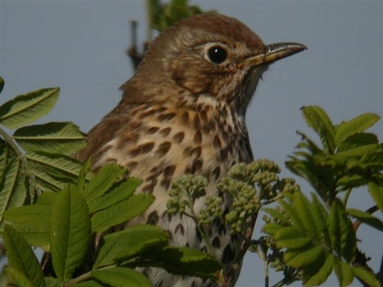Dawn Chorus

One of the birding delights of May is to listen to the dawn chorus. By May, most of our summer visitors have arrived and our woods and gardens particularly are full of bird song. What does it mean? Song is to do with territory, with its food and the opportunities to breed. While bird song gives great pleasure to a great many humans, to other birds the message is “this is my patch”. It is meant as a “come on” to the fairer sex and a warning to rivals.
Why dawn? There could be various reasons: sound carries twenty times better at dawn than in the middle of the day, birds who are able to sing well after a night without food demonstrate their vigour, egg laying is often close to dawn, and when the light gets up the hunt for food becomes a bigger priority.
If you listen regularly to the dawn chorus, there seems to a sequence. Robins are often the first to sing, closely followed by Blackbirds, Song Thrushes, and then Wrens.
Next are warblers like the Chiffchaff and Willow Warbler, along with some of our resident birds like the Chaffinch and House Sparrow. Between first and last can be a couple of hours. Research seems to suggest that this order may be related to the size of the eye, birds with the largest eye singing first.
While the dawn chorus can be a cacophony of noise to humans trying to sleep, bird song has been an inspiration to many of our poets. For example the song of the Skylark sung from on high influenced many poets including Shelley, Blake, Wordsworth and George Meridith whose poem begins:
“He rises and begins to round
He drops the silver chain of sound
Of many links without a break….”
While this captures the essence of what Wordsworth called the “ethereal minstrel” it is not much help in field identification.
It is a fact that a lot of birds can be heard more easily than they can be seen, and it can be rewarding to be able to identify birds from their song or calls…. but it is a challenge.
Bird books often try to put words to bird sounds. Descriptions like “chack-weet”, “tsee”, “tchook”, “tchink” are not a great help. Putting calls or songs to words is a little more helpful. Imagine the school pupil trying to get the attention of teacher and calling rapidly “teacher, teacher, teacher” and you are close to the call of the Great Tit. Some birds’ names give a clue to the call, like “cuckoo”. Chiffchaff is another, but its two notes might be better represented as “chaffchiff” with some times more “chaff” than “chiff”. Descriptions can help. For example, Song Thrush use short melodious phrases and each is repeated three or four times before moving onto the next one.
By far the best way to get familiar with bird calls and songs is to listen to them. Ideally this should be with an experienced bird watcher. On Saturday 16 May, as part of the Arran Wildlife Festival, there was such an opportunity during a Dawn Chorus Walk lead by staff from the RSPB. At this time of year similar walks are lead by Brodick Country Park Rangers. In addition there are many commercial tape sets, CDs and DVDs of bird calls and songs available for all sorts of home and portable sound systems including iPods and MP3 players. Using a recording is a reliable way to build up your birding skills and add to your enjoyment of the dawn chorus.